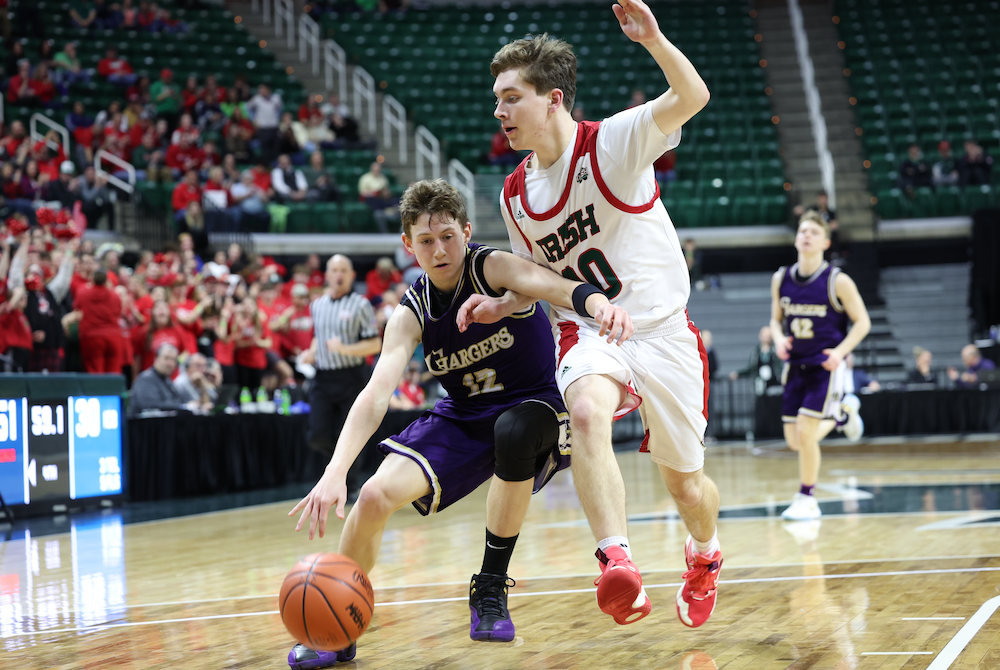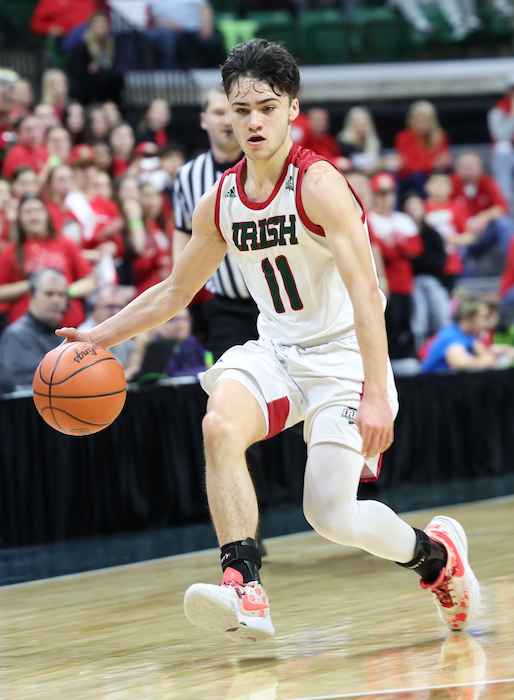
MHSA(Q&)A: Historian Ron Pesch
April 16, 2012
 When we receive a question on the history of MHSAA athletics that we can't answer on the spot, Muskegon's Ron Pesch is the first person we seek out for help.
When we receive a question on the history of MHSAA athletics that we can't answer on the spot, Muskegon's Ron Pesch is the first person we seek out for help.
Pesch took the reins as Michigan's chief high school sports historian during the mid 1990s after the retirement of legendary MHSAA record book originator Dick Kishpaugh and has contributed to various efforts and publications across the state.
One of his latest projects is the awarding of "retro" Mr. Basketball Awards. The first Hal Schram Mr. Basketball Award was given by the Basketball Coaches Association of Michigan in 1981 to Lansing Eastern's Sam Vincent. Three seasons ago, BCAM -- with research work by Pesch -- began awarding retro winners for the previous decades beginning with the 1920s. This winter, BCAM honored retro winners from 1922, 1932, 1942, 1952, 1962 and 1972.
Click to read more about those winners and the finalists recognized last month. Also, click for links to the previous retro winners. The retro Mr. Basketball project will last seven more seasons. Pesch explains more below.
How did you come up with rewarding a “Retro” Mr. Basketball?
The project came out of a conversation I had with (BCAM executive director) Tom Hursey at the basketball finals back in '99. Together, we hatched an approach honoring the state's past basketball greats. He let me run with it, while he worked on getting a subcommittee launched to make the selection.
How do you dig up all of this nomination info?
Between votes, I work on digging out the details. My initial target list always begins with all-state teams - if, of course they exist. All-tournament teams for the early years also serve as a starting point -- if they exist. Best I can tell, the Detroit Times, the Free Press and the News have all named all-state squads, at various points, back to about 1935. The Associated Press and UPI came to the game much later - somewhere around the early to mid 1960s. I then work on creating a crosstab on the players selected, noting the "teams" on which they were named (Class A 1st team, Dream Team, Class C 3rd team), and try to find quotes detailing their games. The result is really a reflection of the times and the history of newspaper reporting.
In early years, we can struggle to uncover a player’s first name, let alone his class in school. And statistical coverage of a player's abilities was very limited. It's simply the way things were back then. Everyone in town knew King Lewis, or Red Cherry, or Young Jacks. And the final box score only contained points, fouls, substitutions, as they were all you really needed to know about the game. But by visiting the state library in Lansing, and looking at a cross-section of newspapers, you can usually dig out what you need.
Do you collect from other sources as well?
Another source is high school yearbooks. Some resources have started to emerge online. I also tap into the MHSAA site and make contact with ADs around the state, asking for their assistance on digging out details - especially class in school. Like the current program, only "seniors" are considered for the award. Mid-year graduates can create a challenge, but the rule currently in place is a player is considered a nominee in the year in which he was last eligible for the state tournament. In other words, if you graduated in January or February of 1943, you would be considered for the 1942 ballot. It appears that a similar approach was used in selecting all-state teams.
|
Year |
Player |
High School |
Age |
Height |
Weight |
Year |
DFP |
DN |
DT |
AP |
UPI |
Tourney |
|
1971 A-1 G. |
Frank Tanana, Jr. (C) |
Detroit Catholic Central |
17 |
6-3 |
170 |
Sr. |
A1 |
A1 |
A1 |
A1 |
||
|
1971 A-1 C |
Tom McGill |
Flint Northern |
17 |
6-3 |
190 |
Sr. |
A1 |
DM |
A1 |
A1 |
||
|
1971 A-1 F. |
Lindsay Hairston |
Detroit Kettering |
17 |
6-9 |
203 |
Sr. |
A1 |
DM |
A1 |
A1 |
||
|
1971 A-1 F. |
Campy Russell |
Pontiac Central |
18 |
6-7 |
190 |
Sr. |
A1 |
DM |
A1 |
A1 |
That cross-tab table will help establish a list of nominees. A consensus first-team pick is an obvious candidate. When only a single all-state team is available, I'll do what I can to look up all-conference teams or all-area teams from around the state to see who else might be considered. While life after high school is not a considered when trying to pick a winner, a player who emerges as a star in college or in the pros may emerge as a candidate when you see his details in a local paper.
Bios are assembled from the newspaper reports, detailing as much as we can find on high school player's career. I'll tap into a variety of resources including old team histories when available. When needed, I'll toss out request to reporters, old and new, around the state. Local librarians and historians are another wonderful resource.
How does voting work?
Between sessions of the Boys Finals, the committee assembles to hash out a final ballot, and to make a selection. I don't vote, but I may guide the conversation and provide any additional details when needed, reminding members that we're focusing on their high school careers. The process is certainly imperfect. But the committee approach prevents the process from becoming a popularity contest. These guys have the benefit of watching many of the players play. And, like the current Mr. Basketball program, they sometimes surprise. But that's what makes it fun. And, of course, stirs the pot. It gets people talking about the history of basketball in this state.
Is there a theme to MHSAA basketball that has remained constant over the years?
For me the greatest thing about the basketball tournament is that it assembles a wide range of folks who want to see players they've heard about in action. And the process, for the most part, hasn't change since the 1920s. While the style of the game has changed, winning a title is much the same as it was back when our great-grandfathers played: You gotta get through the tournament. And only four trophies are awarded.
These guys were the "Magic" of their day. I'm hoping we never forget that.

Lockdown 'D' Proves Key Again as Sacred Heart Continues Title Pursuit
By
Keith Dunlap
Special for MHSAA.com
March 14, 2024
EAST LANSING — When your biggest team strength is actually stronger than it’s been all year, that’s pretty much a formula for victory.
Such was the case for Mount Pleasant Sacred Heart in its Division 4 Semifinal on Thursday.
The Irish have ridden their defense all year, and did so even more against Allen Park Inter-City Baptist, holding the Chargers to a season-low point total in claiming a 51-33 win at Breslin Center.
Sacred Heart (26-2) advanced to meet Wyoming Tri-unity Christian in the championship game at 10 a.m. on Saturday.
“We play unbelievable defense,” Sacred Heart head coach Justin Sherlock said. “That’s what got us here this far. When you get into the last week of the regular season, it’s one-day preps and you have to stick to your fundamentals. Our guys did that.”
Sacred Heart held Inter-City Baptist to 25.6-percent shooting from the field overall (11 of 43) and 3 of 15 from 3-point range.
“They dictated the game defensively,” Inter-City Baptist head coach Mark Kraatz said. “We haven’t struggled to score this year. Kudos to them. They were able to control us and force us to take shots we haven’t done all year.”
 Sacred Heart didn’t exactly light it up from 3-point range (4 of 17), but was 14 of 21 on 2-point shots to make up for it.
Sacred Heart didn’t exactly light it up from 3-point range (4 of 17), but was 14 of 21 on 2-point shots to make up for it.
“Our offense didn’t look too good in the first half,” Sacred Heart sophomore Noah Zeien said. “We were shooting a lot of threes, and we were bricking them. In that second half, we picked it up on offense and our defense did the same. I think that’s what won us the game.”
Zeien scored 19 points, and senior Aidan Halliday added 11 to lead Sacred Heart (26-2).
Now, the Irish will get a chance for redemption. Sacred Heart suffered a 71-41 loss at Tri-unity Christian in the second game of the season, and Sherlock hopes that experience will pay dividends.
“We’re different now,” Sherlock said. “That was 24 games ago. We’ve gotten better. We’ve gelled more as a team, and I have no doubt our guys won’t be afraid on Saturday. It’s for a state championship.”
Senior Andrew Frank scored 13 points in defeat for Inter-City Baptist (23-5), which made its first Semifinal appearance since its Class D championship year 1985.
“That was not a representation of how we’ve played (this year), but it was also a fair representation of how the opposing team played,” Kraatz said. “They played well. Their defense was just gritty and tough.”
Sacred Heart used a 10-2 run late in the second quarter to take a 22-16 lead into halftime, and then continued that momentum in a big way to start the third quarter.
The Irish opened the third with a 12-0 run to take a 34-16 lead midway through the period and put Inter-City Baptist in a deep hole.
Sacred Heart built its lead to 37-19 with 1:16 left in the third and took a 37-22 lead into the fourth quarter.
Inter-City Baptist cut its deficit to 13 on a couple occasions in the fourth, but that was as close as the Chargers would get.
PHOTOS (Top) Sacred Heart’s Alex Latham (20) walls off Inter-City Baptist’s Luke Taylor during Thursday night’s Semifinal at Breslin Center. (Middle) Grady Pieratt brings the ball upcourt for the Irish. (Photos by Hockey Weekly Action Photos.)

